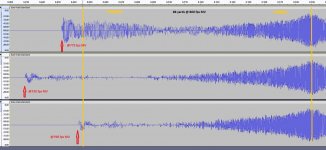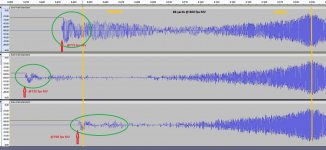Here are three signatures from different setups at ~88 yards.
The first is a shot from a Talon P tuned to shoot JSB Heavy (15.89, .20 cal) at 800 fps for about 22 foot pounds. The rifle is bare. The second is a shot from the same rifle with a "Standard" moderator with gyroid infil. This is a .22 caliber moderator which is a~130mm by 30mm with an internal volume that calculates to ~92cc. The third is from that rifle with a "Krait" (which is simply a large "Ember" and you can see more about that moderator in this thread. The "Kriat" is 40mm x 127mm with a calculated volume of ~160cc (almost 75% larger than the "Standard").
The sensor is about 88 yards from the shooting station. Time of flight with a launch velocity of 800 fps for that pellet would be about 386ms. It takes sound about 240ms to traverse 88 yards with todays conditions. That lets us identify the shot signature relative to the loudest part of the "zzziiiippppp" signature of the pellet flying over the sensor. It SHOULD be around 146 ms before the zip.. And we KNOW that the echo can not reach the sensor BEFORE the initial sound because the shortest distance between two points is a straight line SO:

That's fun. There are a lot of things you can do with a cell phone and "Audacity". Make a cheap (and accurate) chrony? Sure if you already know the BC and range and have a ballistics program that calculates time to target.
The top track shows a much larger shot signature than the bottom two. I shot three shots each and selected the loudest of the three so that it would be easy to see the peaks on the trace. It sort of confused me a bit when I saw the large discrepancy in muzzle velocity but I puzzled it out. I need to lube that hammer.
Here's the audio, 1) Bare 2) Standard 3) Krait:
The first is a shot from a Talon P tuned to shoot JSB Heavy (15.89, .20 cal) at 800 fps for about 22 foot pounds. The rifle is bare. The second is a shot from the same rifle with a "Standard" moderator with gyroid infil. This is a .22 caliber moderator which is a~130mm by 30mm with an internal volume that calculates to ~92cc. The third is from that rifle with a "Krait" (which is simply a large "Ember" and you can see more about that moderator in this thread. The "Kriat" is 40mm x 127mm with a calculated volume of ~160cc (almost 75% larger than the "Standard").
The sensor is about 88 yards from the shooting station. Time of flight with a launch velocity of 800 fps for that pellet would be about 386ms. It takes sound about 240ms to traverse 88 yards with todays conditions. That lets us identify the shot signature relative to the loudest part of the "zzziiiippppp" signature of the pellet flying over the sensor. It SHOULD be around 146 ms before the zip.. And we KNOW that the echo can not reach the sensor BEFORE the initial sound because the shortest distance between two points is a straight line SO:

That's fun. There are a lot of things you can do with a cell phone and "Audacity". Make a cheap (and accurate) chrony? Sure if you already know the BC and range and have a ballistics program that calculates time to target.
The top track shows a much larger shot signature than the bottom two. I shot three shots each and selected the loudest of the three so that it would be easy to see the peaks on the trace. It sort of confused me a bit when I saw the large discrepancy in muzzle velocity but I puzzled it out. I need to lube that hammer.
Here's the audio, 1) Bare 2) Standard 3) Krait:
